Plant of the Month for January, 2022

Here in Toronto, I start looking for Galanthus nivalis, (Milk-flower of the Snow), the common snowdrop, in mid-December. Tips are visible whenever the snow melts. I expect to see the first flowers in mid-January, though they may not appear till the end of February. Those in colder spots may not open until late March. There are now thousands in our garden so we have flowers from February to May.
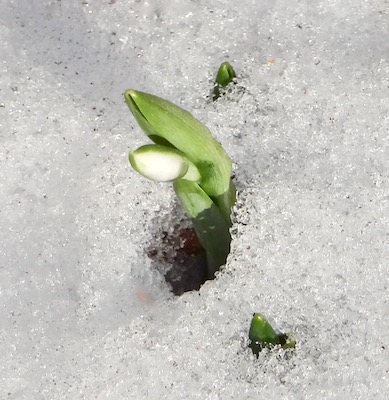
Galanthus elwesii 2021/02/03
Species and Cultivars:
Galanthus nivalis is native to Europe. Two thin grey-green leaves grow from each bulb. A leafless flower stalk can be up to 15 cm high with a dangling white “bell”. The three outer tepals are like long thin spoons. The three inner tepals are much shorter and are not curved. They are characteristically marked with a greenish U over the terminal notch.
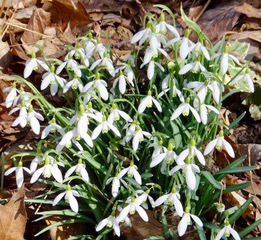 Galanthus nivalis
Galanthus nivalis
There are many hybrids and cultivars although there are only 20 species. Galanthophiles will pay $1000s for a new form with different markings. I am content with a few distinct forms.
G. nivalis F. pleniflorus 'Flore Pleno' grew on an ivy-covered bank close to my home in England. Cut flowers were thought to be unlucky in the house. However, we gathered bunches to sell for church fund raising. These bulbs were planted about 1900 and made a fine show as we walked past after our wedding in 1965.
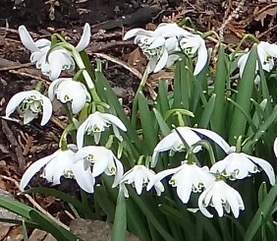
Galanthus nivalis 'Flore Pleno'
I have some clumps of double snowdrops here which are rapidly bulking up. There are 5 or 6 outer tepals and many inner ones.
At first glance, Galanthus elwesii, the giant snowdrop, appears similar, though larger. It grows up to 25 cm tall and the wider leaves fold around each other. The inner tepals have green tips and bases. The amount of green varies considerably.
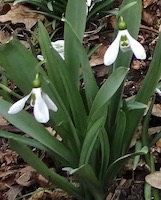
Galanthus elwesii
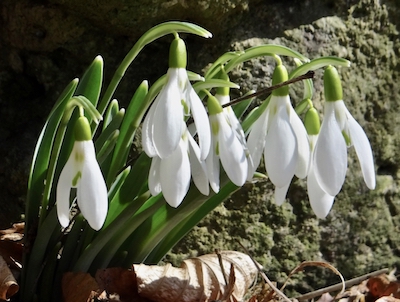
Galanthus elwesii - longer tepals
Some I grow include:
- ‘Magnet’ has long stems so the flowers twist in the breeze.
- ‘S. Arnott’ has tepals which spread out more.
- ‘Green Tips’ has green on the tip of the outer tepals. Unfortunately my clump, though growing well, has only a faint hint of yellow, not green.
- My favourite just appeared in the garden (I am always checking). They have shorter outer tepals which stick out looking like little propellers. Look out for different forms. Many choice bulbs just appeared in gardens and the wild.
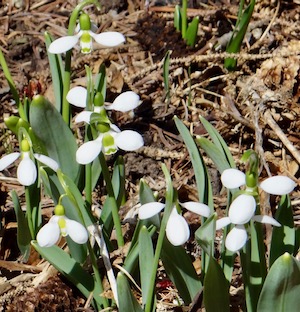
Galanthus elwesii "propeller"
Snowdrops with yellow markings on the tepals and a yellow ovary are sought-after forms. I have some. However, is the yellow caused by a mineral deficiency or lack of light? I will be excited if they stabilize.
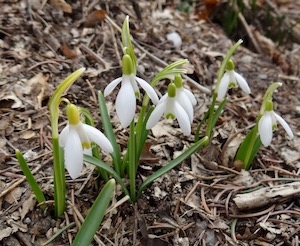
Galanthus nivalis - yellow form
Galanthus elwesii var. monostictus flowers in November. The tepals look more like G. nivalis. This is in my alpine house till it bulks up. One of our members has G. elwesii Hiemalis Group which flowers outside in December.
Cultivation: Plant the bulbs as soon as possible in the early fall. They do not like drying out so first soak them in warm water for a few hours. Deciduous shade and woodsy soil is best though they will tolerate some sun and heavier soil in Southern Ontario. For the earliest flowers, plant in front of a south-facing basement window. The leaves are not attractive after flowering. They soon die down. Hosta and fern leaves hide these. Clumps of Hemerocallis planted on the south side of your snowdrops also make the leaves less obvious.
Propagation: Seed needs to be fresh sown outside and kept shaded and damp. Some will germinate the following spring. I have self-seeded clumps in the lawn. Divide large clumps after flowering “in the green” with the leaves still healthy. Replanting 5-6 bulbs together works best.
I would like a form with nearly all green flowers, also a better yellow and one with really green tips.
A must for snowdrop fanatics: Galanthus Group
Contributed by Anna Leggatt
